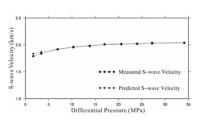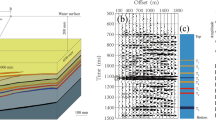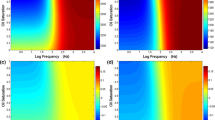Abstract
Shear-wave velocity is essential in various seismic exploration applications, including seismic modeling, amplitude variation with offset analysis, multicomponent seismic data interpretation and other exploration applications. This study presents a simple but effective method for S-wave velocity prediction from P-wave velocity based on granular media model. In the proposed method, the soft-sand, intermediate stiff-sand and stiff-sand models are unified with the expression of the soft-sand model with an effective coordination number. The shear modulus of dry rocks can be related to bulk modulus through the coordination number in the unified model. Elastic-wave velocities of water-saturated rocks at low frequencies can be predicted from the moduli of dry rock using Gassmann’s equation. Thus, the coordination number can be inverted from P-wave velocity of saturated rocks by combining the unified granular media model and Gassmann’s equation. Eventually, S-wave velocity of saturated rock is computed with the inverted effective coordination number. The numerical results indicate that the predicted S-wave velocities agree well with the measured velocities for the laboratory data and well logging data. The proposed method is applicable to sandstones with lithification of large ranges because the unified granular media model accounts for the media between Hashin–Shtrikman lower bound and upper bound. Moreover, the new method is quite suitable for the prediction of S-wave velocity in sandstones deposited in deep-water environment, particularly for turbidite sediment.




Similar content being viewed by others
References
Avseth P, Dvorkin J, Mavko G, Rykkje J (2000) Rock physics diagnostic of North Sea sands: link between microstructure and seismic properties. Geophys Res Lett 27:2761–2764
Avseth P, Jørstad A, Van Wijngaarden AJ, Mavko G (2009) Rock physics estimation of cement volume, sorting, and net-to-gross in North Sea sandstones. Lead Edge 28:98–108
Bachrach R, Avseth P (2008) Rock physics modeling of unconsolidated sands: accounting for nonuniform contacts and heterogeneous stress fields in the effective media approximation with applications to hydrocarbon exploration. Geophysics 73:E197
Batzle ML, Han DH, Hofmann R (2006) Fluid mobility and frequency-dependent seismic velocity—Direct measurements. Geophys J Soc Explor Geophysicists 71:N1
Biot MA (1962) Mechanics of deformation and acoustic propagation in porous media. J Appl Phys 33:1482–1498
Bjørlykke K, Jahren J (2010) Sandstones and sandstone reservoirs. In: Petroleum Geoscience. Springer, Berlin
Castagna JP, Batzle ML, Eastwood RL (1985) Relationships between compressional-wave and shear-wave velocities in clastic silicate rocks. Geophysics 50:571–581
Dvorkin J, Nur A (1996) Elasticity of high-porous sandstones: theory for two North Sea data sets. Geophysics 61:1363–1370
Gaiser JE (1996) Multicomponent Vp/Vs correlation analysis. Geophysics 61:1137–1149
Gassmann F (1951) Über die elastizität poröser medien: Vier. der Natur. Gesellschaft Zürich 96:1–23
Greenberg ML, Castagna JP (1992) Shear-wave velocity estimation in porous rocks—theoretical formulation, preliminary verification and applications. Geophys Prospect 40:195–209
Han DH, Nur A, Morgan D (1986) Effects of porosity and clay content on wave velocities in sandstones. Geophysics 51:2093–2107
Hossain Z, Mukerji T, Dvorkin J, Fabricius IL (2011) Rock physics model of glauconitic greensand from the North Sea. Geophysics 76:199
Jørstad A, Mukerji T, Mavko G (1999) Model-based shear-wave velocity estimation versus empirical regressions. Geophys Prospect 47:785–797
Kuster GT, Toksoz MN (1974) Velocity and attenuation of seismic waves in two-phase media; Part II, experimental results. Geophysics 39:607
Lee MW (2006) A simple method of predicting S-wave velocity. Geophysics 71:F161–F164
Liu Z, Sun SZ (2015) The differential Kuster-Toksöz rock physics model for predicting S-wave velocity. J Geophys Eng 12:839–848
Mavko G, Mukerji T, Dvorkin J (2009) The rock physics handbook: tools for seismic analysis of porous media. Cambridge University Press, Cambridge
Mindlin RD (1949) Compliance of elastic bodies in contact. J Appl Mech 16:259–268
Nur AM, Mavko G, Dvorkin J, Gal D (1995) Critical porosity; a key to relating physical properties to porosity in rocks. Lead Edge 17:878–881
Pride SR, Berryman JG, Harris JM (2004) Seismic attenuation due to wave-induced flow. J Geophys Res. https://doi.org/10.1029/2003JB002639
Rutherford SR, Williams RH (1989) Amplitude-versus-offset variations in gas sands. Geophysics 54:680–688
Sun Z, Jian Z, Stock JM, Larsen HC, Klaus A, Alvarez Zarikian CA, Expedition 367/368 Scientists (2018) Proceedings of the international ocean discovery program, Volume 367/368/Site U1499
Wang Z (2000) Velocity relationships in granular rocks. In: Wang Z, Nur A (eds) Seismic and acoustic velocities in reservoir rocks, pp 145–158
Wang Z (2012) Fundamentals of seismic rock physics. Geophysics 66:398–412
Winkler JR (1993) Numerical recipes in C: The art of scientific computing. In: W. H. Press, S. A. Teukolsky, W. T. Vetterling, B. P. Flannery, Cambridge University Press, Cambridge 201
Wood AB (1941) A textbook of sound. G. Bell and sons, London
Xu S, White RE (1995) A new velocity model for clay-sand mixture. Geophys Prospect 43:91–118
Xu S, White RE (1996) A physical model for shear-wave velocity prediction. Geophys Prospect 44:687–717
Yang Y, Yin X, Gao G, Gui Z, Zhao B (2019) Shear-wave velocity estimation for calciferous sandy shale formation. J Geophys Eng 16:105–115
Zhao L, Han D-H, Yao Q, Zhou R, Yan F (2015) Seismic reflection dispersion due to wave-induced fluid flow in heterogeneous reservoir rocks. Geophysics 80:D221–D235
Acknowledgements
This work was funded by National Key Research and Development Program of China (No. 2018YFC0310105), Hainan Provincial Natural Science Foundation of China (No. 418MS120), Innovative Research Team Program of Natural Science Foundation of Hainan Province (No. 2018CXTD346), and Major State Basic Research Development Program (2015CB251201). Two anonymous reviewers are acknowledged for their constructive comments.
Author information
Authors and Affiliations
Corresponding author
Additional information
Publisher's Note
Springer Nature remains neutral with regard to jurisdictional claims in published maps and institutional affiliations.
Appendix
Appendix
A. Gassmann equation
The Gassmann (1951) equation has been widely used for calculating the effect of fluid substitution on elastic properties using the frame properties. It assumes a homogeneous mineral modulus and statistical isotropy of the pore space but is free of assumptions about the pore geometry. To be most noteworthy, the Gassmann theory is based on low frequency assumption such that the induced pore pressures are equilibrated throughout the pore space (Mavko et al. 2009). The bulk modulus of a fluid-saturated porous medium is calculated using the bulk moduli of the solid grains, the frame, and the pore fluid through the following equation:
where \(K^{*}\) is the bulk modulus of a rock saturated with a fluid of bulk modulus \(K_{f}\), \(K_{d}\) is the frame bulk modulus, \(K_{s}\) is the grain bulk modulus, and \(\varphi\) is porosity. The shear modulus \(G^{*}\) of the rock is not affected by pore fluid, thus
where \(G_{d}\) is the frame shear modulus of the rock. The density \(\rho^{*}\) of the saturated rock is computed by the follow equation,
where \(\rho_{d}\) is the density of dry rock, and \(\rho_{f}\) is the pore fluid’s density. To be noted, \(\rho_{d} = \left( {1 - \varphi } \right)\rho_{s}\), where \(\rho_{s}\) is the grain density (Wang 2012).
When the pore fluid consists of various phases, the bulk modulus \(K_{f}\) of a fluid mixture can be calculated using Wood’s equation (Wood 1941):
where \(K_{w}\), \(K_{o}\), and \(K_{g}\) are the bulk modulus of water, oil and gas, respectively; \(S_{w}\), \(S_{o}\), and \(S_{g}\) are the water, oil and gas saturations respectively. Equation 19 indicates that the pore fluid is uniformly distributed in the pores of the rocks.
Rights and permissions
About this article
Cite this article
Wang, J., Wu, S., Zhao, L. et al. An effective method for shear-wave velocity prediction in sandstones. Mar Geophys Res 40, 655–664 (2019). https://doi.org/10.1007/s11001-019-09396-4
Received:
Accepted:
Published:
Issue Date:
DOI: https://doi.org/10.1007/s11001-019-09396-4




